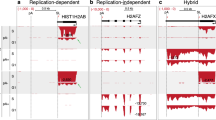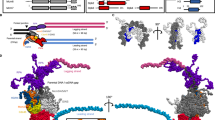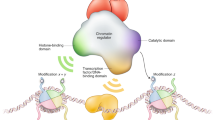Abstract
Eukaryotic cells coordinately regulate histone and DNA synthesis. In mammalian cells, most of the regulation of histone synthesis occurs post-transcriptionally by regulating the concentrations of histone mRNA. As cells enter S phase, histone mRNA levels increase, and at the end of S phase they are rapidly degraded. Moreover, inhibition of DNA synthesis causes rapid degradation of histone mRNAs. Replication-dependent histone mRNAs are the only metazoan mRNAs that are not polyadenylated. Instead, they end with a conserved stem-loop structure, which is the only cis-acting element required for coupling regulation of histone mRNA half-life with DNA synthesis. Here we show that regulated degradation of histone mRNAs requires Upf1, a key regulator of the nonsense-mediated decay pathway, and ATR, a key regulator of the DNA damage checkpoint pathway activated during replication stress.
This is a preview of subscription content, access via your institution
Access options
Subscribe to this journal
Receive 12 print issues and online access
$259.00 per year
only $21.58 per issue
Buy this article
- Purchase on SpringerLink
- Instant access to full article PDF
Prices may be subject to local taxes which are calculated during checkout







Similar content being viewed by others
Accession codes
References
Nelson, D.M. et al. Coupling of DNA synthesis and histone synthesis in S-phase independent of cyclin/cdk2 activity. Mol. Cell. Biol. 22, 7459–7472 (2002).
Ye, X. et al. Defective S phase chromatin assembly causes DNA damage, activation of the S phase checkpoint, and S phase arrest. Mol. Cell 11, 341–351 (2003).
Sancar, A., Lindsey-Boltz, L.A., Unsal-Kacmaz, K. & Linn, S. Molecular mechanisms of mammalian DNA repair and the DNA damage checkpoints. Annu. Rev. Biochem. 73, 39–85 (2004).
Sittman, D.B., Graves, R.A. & Marzluff, W.F. Histone mRNA concentrations are regulated at the level of transcription and mRNA degradation. Proc. Natl. Acad. Sci. USA 80, 1849–1853 (1983).
Dominski, Z. & Marzluff, W.F. Formation of the 3′ end of histone mRNA. Gene 239, 1–14 (1999).
Dominski, Z., Zheng, L.-X., Sanchez, R. & Marzluff, W.F. The stem-loop binding protein facilitates 3′ end formation by stabilizing U7 snRNP binding to the histone pre-mRNA. Mol. Cell. Biol. 19, 3561–3570 (1999).
Sanchez, R. & Marzluff, W.F. The stem-loop binding protein is required for efficient translation of histone mRNA in vivo and in vitro. Mol. Cell. Biol. 22, 7093–7104 (2002).
Pandey, N.B. & Marzluff, W.F. The stem-loop structure at the 3′ end of histone mRNA is necessary and sufficient for regulation of histone mRNA stability. Mol. Cell. Biol. 7, 4557–4559 (1987).
Harris, M.E. et al. Regulation of histone mRNA in the unperturbed cell cycle: evidence suggesting control at two posttranscriptional steps. Mol. Cell. Biol. 11, 2416–2424 (1991).
Maquat, L.E. Nonsense-mediated mRNA decay: splicing, translation and mRNP dynamics. Nat. Rev. Mol. Cell Biol. 5, 89–99 (2004).
Lykke-Andersen, J., Shu, M.D. & Steitz, J.A. Human Upf proteins target an mRNA for nonsense-mediated decay when bound downstream of a termination codon. Cell 103, 1121–1131 (2000).
Kim, V.N., Kataoka, N. & Dreyfuss, G. Role of the nonsense-mediated decay factor hUpf3 in the splicing-dependent exon-exon junction complex. Science 293, 1832–1836 (2001).
Graves, R.A., Pandey, N.B., Chodchoy, N. & Marzluff, W.F. Translation is required for regulation of histone mRNA degradation. Cell 48, 615–626 (1987).
Kaygun, H. & Marzluff, W.F. Translation termination is involved in histone mRNA degradation when DNA replication is inhibited. Mol. Cell. Biol. 25, 6879–6888 (2005).
Wells, D. & Kedes, L. Structure of a human histone cDNA: evidence that basally expressed histone genes have intervening sequences and encode polyadenylated mRNAs. Proc. Natl. Acad. Sci. USA 82, 2834–2838 (1985).
Brush, D., Dodgson, J.B., Choi, O.R., Stevens, P.W. & Engel, J.D. Replacement variant histone genes contain intervening sequences. Mol. Cell. Biol. 5, 1307–1317 (1985).
Czaplinski, K., Weng, Y., Hagan, K.W. & Peltz, S.W. Purification and characterization of the Upf1 protein: a factor involved in translation and mRNA degradation. RNA 1, 610–623 (1995).
Sun, X., Perlick, H.A., Dietz, H.C. & Maquat, L.E. A mutated human homologue to yeast Upf1 protein has a dominant-negative effect on the decay of nonsense-containing mRNAs in mammalian cells. Proc. Natl. Acad. Sci. USA 95, 10009–10014 (1998).
Leeds, P., Wood, J.M., Lee, B.-S. & Culbertson, M.R. Gene products that promote mRNA turnover in Saccharomyces cerevisiae. Mol. Cell. Biol. 12, 2165–2177 (1992).
Perlick, H.A., Medghalchi, S.M., Spencer, F.A., Kendzior, R.J., Jr. & Dietz, H.C. Mammalian orthologues of a yeast regulator of nonsense transcript stability. Proc. Natl. Acad. Sci. USA 93, 10928–10932 (1996).
Weng, Y., Czaplinski, K. & Peltz, S.W. Genetic and biochemical characterization of mutations in the ATPase and helicase regions of the Upf1 protein. Mol. Cell. Biol. 16, 5477–5490 (1996).
Whitfield, M.L. et al. Stem-loop binding protein, the protein that binds the 3′ end of histone mRNA, is cell cycle regulated by both translational and posttranslational mechanisms. Mol. Cell. Biol. 20, 4188–4198 (2000).
Zheng, L. et al. Phosphorylation of SLBP on two threonines triggers degradation of SLBP, the sole cell-cycle regulated factor required for regulation of histone mRNA processing, at the end of S-phase. Mol. Cell. Biol. 23, 1590–1601 (2003).
Whitfield, M.L. et al. SLBP is associated with histone mRNA on polyribosomes as a component of histone mRNP. Nucleic Acids Res. 32, 4833–4842 (2004).
He, F. & Jacobson, A. Identification of a novel component of the nonsense-mediated mRNA decay pathway by use of an interacting protein screen. Genes Dev. 9, 437–454 (1995).
Schell, T. et al. Complexes between the nonsense-mediated mRNA decay pathway factor human upf1 (up-frameshift protein 1) and essential nonsense-mediated mRNA decay factors in HeLa cells. Biochem. J. 373, 775–783 (2003).
Nghiem, P., Park, P.K., Kim, Y., Vaziri, C. & Schreiber, S.L. ATR inhibition selectively sensitizes G1 checkpoint-deficient cells to lethal premature chromatin condensation. Proc. Natl. Acad. Sci. USA 98, 9092–9097 (2001).
Amrani, N. et al. A faux 3′-UTR promotes aberrant termination and triggers nonsense-mediated mRNA decay. Nature 432, 112–118 (2004).
Maquat, L.E. & Li, X.J. Mammalian heat shock p70 and histone H4 transcripts, which derive from naturally intronless genes, are immune to nonsense-mediated decay. RNA 7, 445–456 (2001).
Le Hir, H., Moore, M.J. & Maquat, L.E. Pre-mRNA splicing alters mRNP composition: evidence for stable association of proteins at exon-exon junctions. Genes Dev. 14, 1098–1108 (2000).
Le Hir, H., Izaurralde, E., Maquat, L.E. & Moore, M.J. The spliceosome deposits multiple proteins 20–24 nucleotides upstream of mRNA exon-exon junctions. EMBO J. 19, 6860–6869 (2000).
Ishigaki, Y., Li, X.J., Serin, G. & Maquat, L.E. Evidence for a pioneer round of mRNA translation: mRNAs subject to nonsense-mediated decay in mammalian cells are bound by CBP80 and CBP20. Cell 106, 607–617 (2001).
Marzluff, W.F., Gongidi, P., Woods, K.R., Jin, J.P. & Maltais, L. The human and mouse replication-dependent histone genes. Genomics 80, 487–498 (2002).
Yamashita, A., Ohnishi, T., Kashima, I., Taya, Y. & Ohno, S. Human SMG-1, a novel phosphatidylinositol 3-kinase-related protein kinase, associates with components of the mRNA surveillance complex and is involved in the regulation of nonsense-mediated mRNA decay. Genes Dev. 15, 2215–2228 (2001).
Ohnishi, T. et al. Phosphorylation of hUPF1 induces formation of mRNA surveillance complexes containing hSMG-5 and hSMG-7. Mol. Cell 12, 1187–1200 (2003).
Pal, M., Ishigaki, Y., Nagy, E. & Maquat, L.E. Evidence that phosphorylation of human Upfl protein varies with intracellular location and is mediated by a wortmannin-sensitive and rapamycin-sensitive PI 3-kinase-related kinase signaling pathway. RNA 7, 5–15 (2001).
Lejeune, F., Li, X. & Maquat, L.E. Nonsense-mediated mRNA decay in mammalian cells involves decapping, deadenylating, and exonucleolytic activities. Mol. Cell 12, 675–687 (2003).
Brumbaugh, K.M. et al. The mRNA surveillance protein hSMG-1 functions in genotoxic stress response pathways in mammalian cells. Mol. Cell 14, 585–598 (2004).
Nabatiyan, A. & Krude, T. Silencing of chromatin assembly factor 1 in human cells leads to cell death and loss of chromatin assembly during DNA synthesis. Mol. Cell. Biol. 24, 2853–2862 (2004).
Kim, Y.K., Furic, L., LesGroseillers, L. & Maquat, L.E. Mammalian Staufen1 recruits Upf1 to specific mRNA 3′UTRs so as to elicit mRNA decay. Cell 120, 195–208 (2005).
Wellman, S.E., Casano, P.J., Pilch, D.R., Marzluff, W.F. & Sittman, D.B. Characterization of mouse H3.3-like histone genes. Gene 59, 29–39 (1987).
Wagner, E.J. & Garcia-Blanco, M.A. RNAi-mediated PTB depletion leads to enhanced exon definition. Mol. Cell 10, 943–949 (2002).
Mendell, J.T., ap Rhys, C.M. & Dietz, H.C. Separable roles for rent1/hUpf1 in altered splicing and decay of nonsense transcripts. Science 298, 419–422 (2002).
Acknowledgements
This work was supported by US National Institutes of Health grant GM29832 to W.F.M. We thank E. Wagner and B. Duronio for critical reading of the manuscript. We thank L. Maquat (University of Rochester) for Upf1 clone, M. Hentze (EMBL) and C. Smith (Cambridge University) for Upf1 antibodies, J. Lykke-Andersen (University of Colorado) for Upf2 antibody, M. Garcia-Blanco (Duke University) for PTB antibody and P. Nghiem (Harvard) for ATR cells.
Author information
Authors and Affiliations
Corresponding author
Ethics declarations
Competing interests
The authors declare no competing financial interests.
Rights and permissions
About this article
Cite this article
Kaygun, H., Marzluff, W. Regulated degradation of replication-dependent histone mRNAs requires both ATR and Upf1. Nat Struct Mol Biol 12, 794–800 (2005). https://doi.org/10.1038/nsmb972
Received:
Accepted:
Published:
Issue date:
DOI: https://doi.org/10.1038/nsmb972
This article is cited by
-
The Rad53CHK1/CHK2-Spt21NPAT and Tel1ATM axes couple glucose tolerance to histone dosage and subtelomeric silencing
Nature Communications (2020)
-
Insights into the assembly and architecture of a Staufen-mediated mRNA decay (SMD)-competent mRNP
Nature Communications (2019)
-
HTLV-1 Tax plugs and freezes UPF1 helicase leading to nonsense-mediated mRNA decay inhibition
Nature Communications (2018)
-
Upf proteins: highly conserved factors involved in nonsense mRNA mediated decay
Molecular Biology Reports (2018)
-
The human RNA surveillance factor UPF1 regulates tumorigenesis by targeting Smad7 in hepatocellular carcinoma
Journal of Experimental & Clinical Cancer Research (2016)



